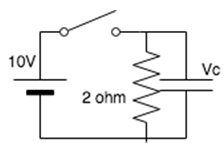This set of Basic Electrical Engineering Multiple Choice Questions & Answers (MCQs) focuses on “Charge and Voltage”.
1. Which among the following expressions relate charge, voltage and capacitance of a capacitor?
a) Q=C/V
b) Q=V/C
c) Q=CV
d) C=Q2V
View Answer
Explanation: Q is directly proportional to V. The constant of proportionality in this case is C, that is, the capacitance. Hence Q=CV.
2. If a 2F capacitor has 1C charge, calculate the voltage across its terminals.
a) 0.5V
b) 2V
c) 1.5V
d) 1V
View Answer
Explanation: Q is directly proportional to V. The constant of proportionality in this case is C, that is, the capacitance. Hence Q=CV. V=Q/C=1/2 V=0.5V.
3. What is the voltage across a capacitor at the time of switching, that is, when t=0?
a) Infinity
b) 0V
c) Cannot be determined
d) 1V
View Answer
Explanation: At the time of switching, when t=0, the capacitor acts as a short circuit. The voltage across a short is always equal to zero hence the voltage across the capacitor is equal to zero.
4. What is the voltage across the capacitor if the switch is closed and steady state is reached?

a) 8V
b) 0V
c) 10V
d) Infinity
View Answer
Explanation: When steady state is reached, the capacitor acts as a open circuit and the 10V is connected in parallel to it. Hence Vc=10V.
5. If one plate of a parallel plate capacitor is charged to positive charge the other plate is charged to?
a) Positive
b) Negative
c) Positive or negative
d) Not charged
View Answer
Explanation: If one plate is charged to positive, the other plate is automatically charged to negative so that it can store electrical charge.
6. When the voltage across a capacitor increases, what happens to the charge stored in it?
a) Increases
b) Decreases
c) Becomes zero
d) Cannot be determined
View Answer
Explanation: When the voltage across a capacitor increases, the charge stored in it also increases because a charge is directly proportional to voltage, capacitance being the constant of proportionality.
7. When will capacitor fully charged?
a) When the voltage across its plates is half the voltage from ground to one of its plates
b) When the current through the capacitor is a 1/root2 time its value
c) When the supply voltage is equal to the capacitor voltage
d) Never
View Answer
Explanation: When the capacitor voltage is equal to the supply voltage the current stops flowing through the circuit and the charging phase is over.
8. What happens to the current flow in a fully charged capacitor?
a) Current flow stops
b) Current flow doubles
c) Current flow becomes half its original value
d) Current flow becomes one-fourth its original value
View Answer
Explanation: When a capacitor is fully charged, it does not store any more charge. There is no change in charge with time. Current is the rate of change of charge, hence it becomes zero, or stops.
9. Calculate the capacitance of a capacitor that stores 40microC of charge and has a voltage of 2V.
a) 20F
b) 20microF
c) 10F
d) 10microF
View Answer
Explanation: Q is directly proportional to V. The constant of proportionality in this case is C, that is, the capacitance. Hence C=Q/V.
C=40microC/2V=20microF.
10. What happens to the capacitance when the voltage across the capacitor increases?
a) Decreases
b) Increases
c) Becomes 0
d) No effect
View Answer
Explanation: Q is directly proportional to V. The constant of proportionality in this case is C, that is, the capacitance. Capacitance is a constant so it will not change on changing voltage.
Sanfoundry Global Education & Learning Series – Basic Electrical Engineering.
To practice all areas of Basic Electrical Engineering, here is complete set of 1000+ Multiple Choice Questions and Answers.
If you find a mistake in question / option / answer, kindly take a screenshot and email to [email protected]
